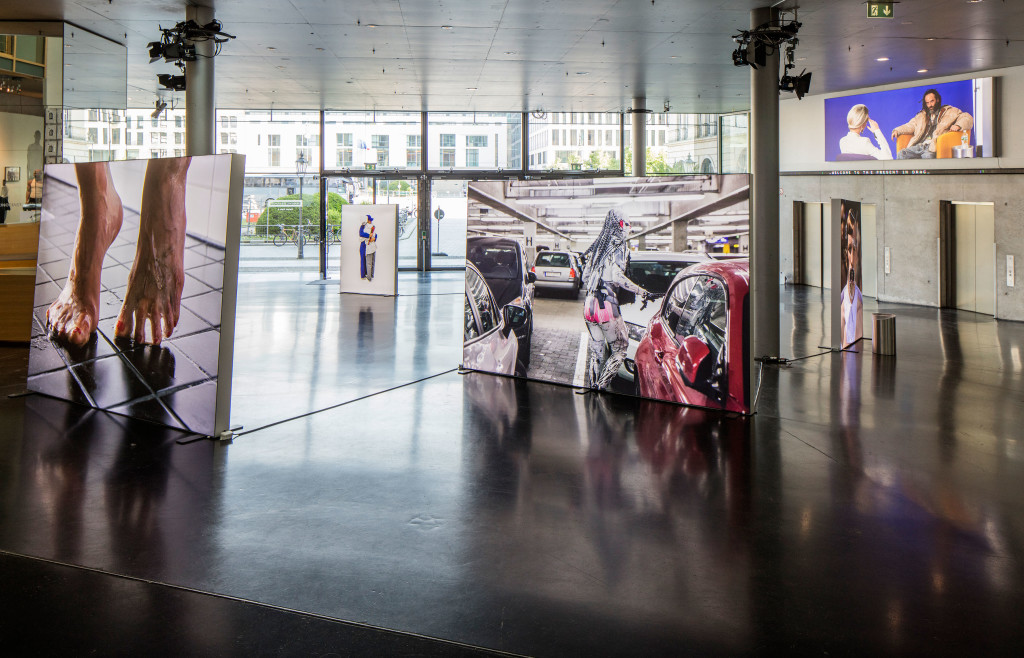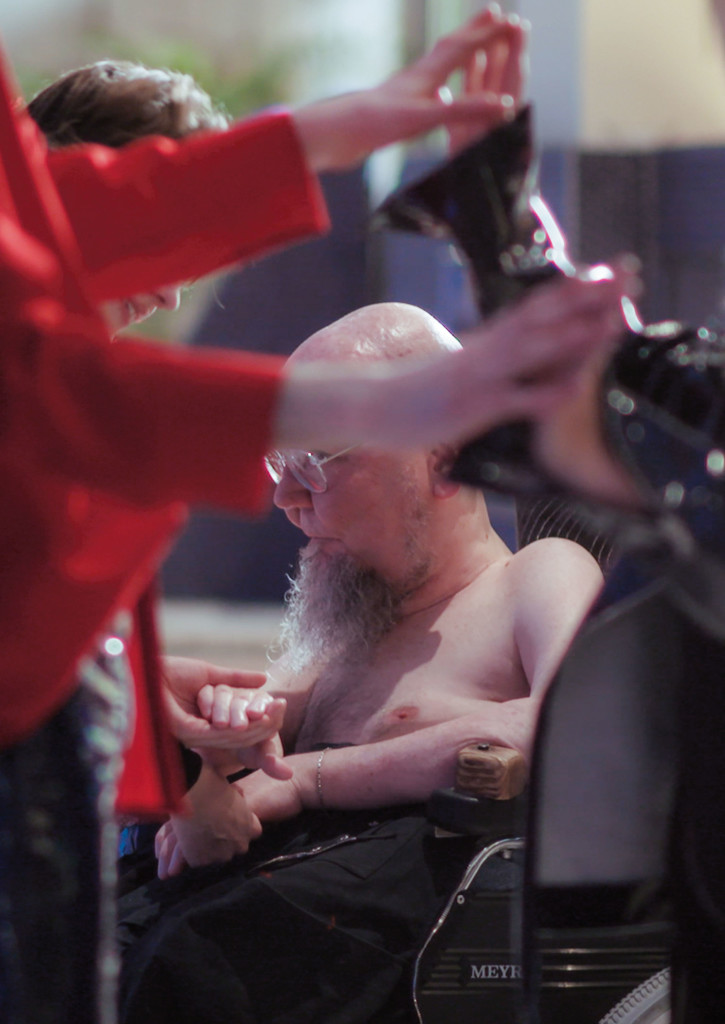9th Berlin Biennale for Contemporary Art
by Vanessa Gravenor
An excess of images, inebriated with shine, a hat on fire, make America great—again. We are all familiar with these image products—commercial narrative arches that manipulate us to feel empathetic consumption. Yet, what happens when you curate this type of Internet culture, cat meme galore, into a Biennale whose excess begins to overflow? You get hyperbole. Yes, this is what the 9th Berlin Biennale is like—a never-ending, carnivalesque hyperbole. Cluster fucks, accumulation, drag jokes, and social highs, the 9th Berlin Biennale, curated by DIS, promises euphoria like capitalism itself, yet all you get in the end is an excess—something like a computer generated orgasm on speed. The Berlin Biennale DISappoints—though to think this wasn’t intentional would be missing its point.

LIT, at the Akademie der Künste is one of the first image sequences that greets you at your Biennale arrival. The exhibition is a series of light boxes exhibiting photographs by different commissioned artists. They stand, triangulated like false monuments, creating a type of somatic space for the viewer. In More Than Some Less Than Others XX (2016) by Martine Syms a light box proclaims the polemic text, “trauma vs. uplift.” GALVINIZE (2016), a work by New York fashion label Hood by Air, displays an image of a black man with teeth extensions in his mouth. Another piece with the same title by the same artist shows a close-up of a white man whose mouth is wired shut, with a lock dangling from one of the oral restrains.
Hito Steyerl’s essay Duty Free Art (2015) comes to mind as LIT’s curators appropriate the aesthetics of a duty free shop, they have hijacked this essay and stuffed it between the cracks of their own fabricated contexts. The images meet somewhere in between the inhuman polish found in advertising and the rough sparkle of apocalyptic dreaming. The exhibition creates a reality where the laws of capital are theoretically suspended in order to promote consumerism that extends beyond geographic and political borders. LIT could be in a duty free zone in Switzerland, Luxembourg, a high rise in Brooklyn, or China. The racial constraints are erased within this system, and all one has are simulations of culture that are created for infinite distribution. Similar to LIT is the project Not in the Berlin Biennale (2016), led by Babak Radboy, which is composed of Telafar’s fashion aesthetics, mannequins, and advertisements that can be found throughout Berlin. One such advertisement depicts a disabled women in an electric wheel chair with the text, “Why do fascists get to have all the fun?”

There are no traces of utopia in this Biennale. In its place is a hyperbolic sadness that penetrates to the core. While sadness can be a political tactic, sorrow itself is by definition belated (after the act). The act of sorrow becomes the activity of Josh Kline’s Crying Games (2015), where George Bush, Dick Cheney, Condoleezza Rice, Donald Rumsfeld, and Tony Blair appear as prisoners crying on the floor of their cells. The figures all say phrases such as “All those people,” and “I’m so sorry.” These are all political figures of the 2000’s that created decisive actions that have tied us into the political knot we call our present moment.
Other pieces such as Markus Löffler and Andree Korpys’ two-channel film Transparenz, Kommunikation, Effizienz, Stabilität (2016) interpose these phrases through SMS notifications onto the architecture of the present European Central Bank Building in Frankfurt am Main. Installed alongside mirrors, the film activates the old concrete bunker that is the Feuerle Collection. Some of the phrases within the piece include quotes from Brecht’s Hand Oracle for City Dwellers, “Iss das Fleisch! (Eat the meat), I speak to you coldly like in reality that you do not understand, there’s nobody here any longer to observe you, or cover your tracks. That is what they taught me.” Spliced between the high definition digital images are poorly rendered Super 8 photographs taken from the Blockup protest of March 18, 2015. These images have an uncanny quality to them in that they slip between times and show the present through the eyes of an apparatus that no longer has sway in our image culture.

One of the more poignant pieces in the Biennale is Army of Love (2016) by Alexa Karolinski/Ingo Niermann, which attempts to tackle love, one of the hardest subjects to portray. The artists assembled individuals such as aging sex workers, disabled paraplegic men, aging women, young punks, a baby, and able bodied people. All the subjects are pictured in a spa-like environment, basking in a florescent blue glow that emanates from the water below. Subjects from the video are interviewed, asked what makes them feel loved, and what aspects of themselves they consider to be attractive to others. One of the most touching lines of the video is delivered by a woman who has difficulty speaking because of her disability; she comments,“We unfortunately live in a society that only is about beauty and performances.” The video tackles the cycle of mortality that all human beings must face, that is the mantra of our lives. Instead of the lackadaisical quip that we are all going to die anyway, Army of Love asks how we can envision an alternative; relationships that make out bodily struggles less challenging, suggesting in its place the possibility of affirmation in a radical caring economy. This of course contrasts the images we first saw in LIT that can only be characterized as fascistic images, where only the young and beautiful succeed at their accelerating quests.

The carnival, Bakhtin explains, creates a type of second life where people in positions of power, such as King and Queen, were parodied. While fools were rendered spectacular, they also were inserted into the fabric of the model, rather than in a place of exclusion. It is important to think of parody in this way, as it is a tactic at the heart of the 9th Berlin Biennale. For instance, Katja Novitskova’s Neolithic Potential (fire worship, yellow horns) (2016) and Expansion Curves (fire worship purple horns) (2016), which are installed in the European School of Management, draws our attention to our literal surroundings of corporate glamour. Novitskova’s fire imagery hyperbolizes the literal damage of corporate capital warfare, while the exhibition texts draws our attention to Neolithic rituals:
Some argue that the socio-economic models underlying contemporary “western” societies originated from the Neolithic cities of the Near East, emerging with the first systems of agricultural production, bull cults, mother goddesses, patriarchy, and proto-Abrahamic mythologies. The cultural residue of these original structures continue to inhabit the visual language of contemporary capitalist societies (from Germany to the US) as well as ruins of their socialist competitors from the twentieth century and other worlds colonized by the west.
Here, we see the activity of parody at work, corroding business image cultures and writing in historical referents for consumerism that otherwise has no heritage. It seems easy, and very tempting to write off laughter, especially ridicule, for these attacks often come from the outside and turn subjects into objects. As critical art goers who also double as intellectuals, we have been taught to fight the object, to degrade anything that doesn’t clearly give agency to others. It of course gets fuzzy when you introduce a new type of gazing, which is entirely based upon speed—the internet gaze. Our image receptors become slighted and our eyes go into a type of daze. Perhaps this is what the curators want us, the viewers, to approach their Biennale from, if they have any agenda at all. Like the adverts proclaim: “Why do fascists get to have all the fun?”
The 9th Berlin Biennale for Contemporary art at the Akademie der Künste, ESMT European School of Management and Technology, The Feuerle Collection, and the KW Institute for Contemporary Art runs through September 18, 2016.